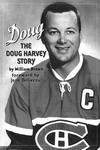Doug Harvey
In 1998, a poll by the venerable Hockey News named the top 100 hockey players of all time. The top five were givens: Wayne Gretzky, Bobby Orr, Gordie Howe, Mario Lemiux, and Maurice Richard. But who was this Doug Harvey, the sixth guy on the list?
Though a rabid hocky fan in my youth, I hadn't heard of Doug Harvey. I was too young apparently to know: Harvey was a stalwart defenceman, one of the Great Canadiens.
But he was more than that: a supporter of the underdog, an instigator in the first version of a players' union in the late '50s, a gun-toting alcoholic, and a manic depressive - what today is labelled bipolar disorder. Harvey spent the later years of his life living in a railway car. (Of course, the car used to be John Diefenbaker's, and had carried other Prime Ministers across Canada, but still.)
The book's unpretentious title is no accident. Brown might have used any number of more scintillating ones to push sales - Doug: Get the Puck Out or Doug: Mentally Mental Illness and the Toronto Maple Leafs . But this is no Oprah pick: Brown knows exactly whom the audience for a book like this is, and he plays it cool and controlled just like the eponymous hero.
Brown has an irreproachable, solid writing style that ploughs through facts and anecdotes like Gretzky through the defence. The book is a heavily researched tribute by a writer who knows, and loves, sports. For all the intricate details of on-ice and boardroom stick-handling, it clips along at a good pace. That said, if you skip the Sports pages in the paper, you'll probably also pass on this book.
"I'm my own man," Harvey keeps repeating through the book, his one and only defence for his sometimes bizarre actions, "This is who I am." Brown is fine with that, and so are almost all of the colourful characters who played with Harvey through the '50s and '60s. That's how it was back then, apparently. A man might have problems, but they were his own problems. Yu didn't go meddling around in his mind any more than you would question the way he played hockey.
 Harvey, who died in 1989, claimed that the main reason management always gave him such a hard time was because in the early days he tried to start a players' association - a short-lived project that lasted only a year. (Most hockey fans will know the hard-luck stories of early NHLers. Even after the NHLPA, Gordie Howe was being paid $14,000 after playing 26 seasons; Harvey collected a meagre $9,000, and Maurice Richard, the top draw at all hockey arenas, took home $7,000 a year.) Harvey, who died in 1989, claimed that the main reason management always gave him such a hard time was because in the early days he tried to start a players' association - a short-lived project that lasted only a year. (Most hockey fans will know the hard-luck stories of early NHLers. Even after the NHLPA, Gordie Howe was being paid $14,000 after playing 26 seasons; Harvey collected a meagre $9,000, and Maurice Richard, the top draw at all hockey arenas, took home $7,000 a year.)
Harvey was a stubborn fighter on the ice and off. During the playoffs in 1959, the fans rioted in the stands and sent goalie Jacques Plante cowering under his net while seats were ripped out and thrown. Only Harvey's intervention - swinging his stick and punching fans (one required 15 stitches) got the rioters to back off. He fought for better conditions for players, too. In the early '50s, NHL players had to pay their own medical, moving and equipment expenses; they had no control over their professional lives. Harvey's activism, he claimed, finally got him traded from the Canadiens. He went to the New York Rangers, then finally to the St. Louis Blues. Near the end of his life, he held court in Montreal taverns, a cheap stogie in his mouth and a grosse Mol tablette in his hand. He had better things to do than to go to his own induction into the Hockey Hall of Fame.
From Brown's interpretation, I have no doubt Harvey was a fine man, and a hell of a lot of fun to be around. After reading the book, though, I had no insight into bipolar disorder or the deep impulses that lead every man to find his place in the world. Like its hero, the book presents itself as simple and straightforward, avoiding going too deeply into the reasons behind a complicated man's behaviour, but you know there'more going on beneath the surface.
|
|
© Copyright 2025 outlawhockey.com All rights reserved.
Unauthorized duplication in part or whole strictly prohibited by international copyright law. |
|
|